Logistics’ guiding hand for Faurecia
Faurecia Interior Systems has a decentralised approach to managing the supply chain, but is trying to take a more complete view for logistics and packaging purchasing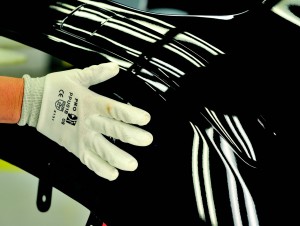
France’s Faurecia Group is an interesting case study in comparing centralised and de-centralised approaches to the supply chain management of a global supplier. Until around five years ago, the company had a group-purchasing organisation to manage the budget across its divisions for seating, interiors, emission control (exhaust), and exteriors. But Faurecia’s leadership decided to change this structure, and separate the budget between the four product groups. For logistics, an operational director oversees the network at each division, while managers at the plant level manage day-to-day operations, such as delivery and pickup frequency.
This structure is relatively free of bureaucratic layers, and contains checks and balances between the plans of Faurecia’s global management, and the local, ‘boots on the ground’ viewpoint of plant directors. Concern for delivery quality and service is paramount, with each plant or region pushing for the most reliable and responsive logistics providers, regardless of whether they are the cheapest or not.
But under such an organisation, there are risks that Faurecia, the world’s sixth largest automotive supplier with around 280 plants globally, surrenders economies of scale along with visibility of total supply chain costs. Marc Louwerse, transport logistics and packaging commodity director at Faurecia Interior Systems, admits that there would be benefits to having a “strategic global supply chain organisation” that designed, purchased and controlled the group’s logistics and supply operations.
“If you look at other tier suppliers, they have purchasing groups who buy and manage 70-80% of services centrally, with the rest left to regions or plants,” says Louwerse.
Louwerse, who spent 15 years in financial control and operations in transport and container shipping and at a consultancy before joining Faurecia in 2002, says logistics shouldn’t be managed in isolation, but for total costs.
Louwerse admits that Faurecia is more focused on its global expansion than building management structures. While the European economy is affecting its business, including declines at fellow group company PSA Peugeot-Citroën, Faurecia generates 45% of revenue outside Europe. It is expanding rapidly in Russia, North America, South America and especially China, where it plans to double its business by 2016.
Partial centralisation
Faurecia does have some central logistics functions. There is a production control and logistics (PC&L) department within the company’s industrial group management. PC&L does not, however, have direct operational and purchasing control over Faurecia’s networks. Rather, similar to the organisations at a number of other tier suppliers, PC&L is closer to an in-house consultancy, designing the network and advising the group’s divisions on how to make their supply chains more efficient.
There is also a reasonable amount of centralisation in Louwerse’s purchasing group at Faurecia Interior Systems, which on its own is Europe’s largest interior supplier, with sales of nearly €3.6 billion ($4.7 billion) last year. Louwerse is responsible for purchasing logistics services for the division, as well as returnable and expendable packaging products. While his responsibility is for interiors, he points to a “dotted line” that links exteriors as well. “Both divisions do plastic injections, and in some cases we have the same tier two suppliers, contracts and other common points which lead to some logistics combinations,” he says.
Louwerse is also involved in group purchasing activities for packaging, including returnable racks and boxes. Such projects are not official strategies so much as the result of good communication between the divisions, he says. There is also some integration of returnable packaging loops between the interior and exterior divisions.
The typical process for managing Faurecia’s network is that the PC&L team designs logistics scheme for each division based on full production, and then Louwerse’s
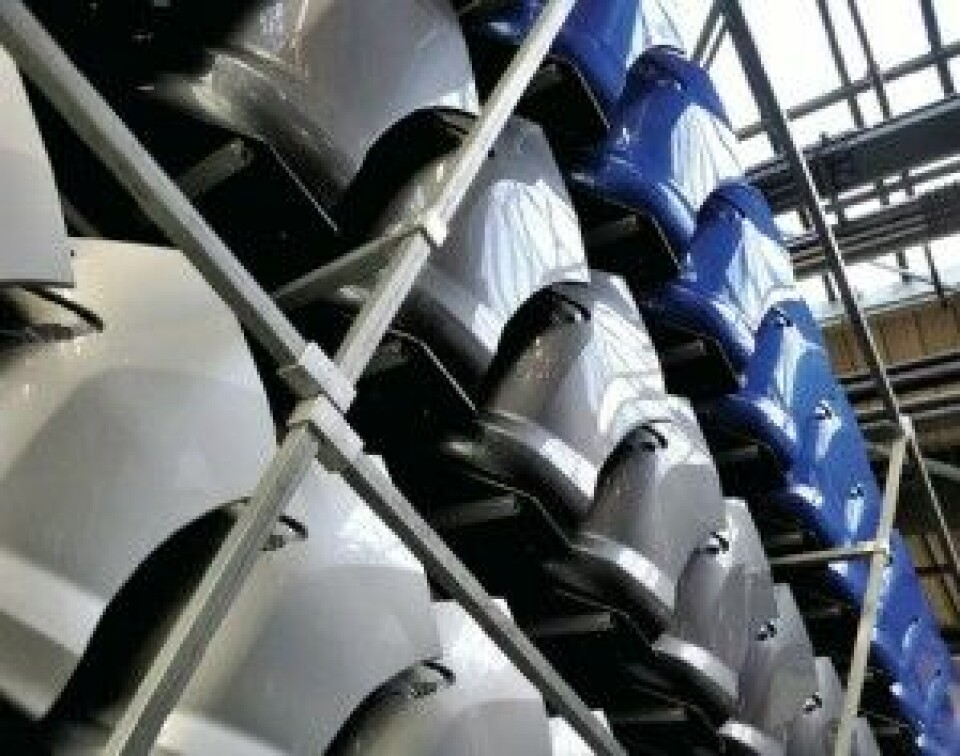
team procures the services. But his role is not just negotiating the contracts to match PC&L’s plans; rather, his team considers the needs of plants and the limits of the market, the outcomes of which sometime means modifying network designs.
“Each region or plant likes to add its little local line-side supplier, who might be located right next door and able to react quickly in any production crisis,” he says. “But I try to integrate those needs with a more global supplier purchasing approach, and try to balance both large and small providers.”
Although he admits that Faurecia used to hold auction-style tenders that went to the lowest bidder, purchasing now considers factors that could trump price, including provider locations, equipment maintenance and performance history. “If you take the case of JIT sequencing and delivery, we need trucks to be at the plant or sequencing centre at precise times, and there is no room for deviation,” he says. “In these situations, the acquisition price is not the key element.”
While his role is not full-time operational, Louwerse’s negotiations are essential to network efficiency. For example, during the last three years the interiors division has developed pan-European crossdocks for consolidating freight from long-distance suppliers. To make it work, Louwerse and his team have had to convince Faurecia’s parts purchasing team to adjust prices to account for the lower total logistics costs.
“We had to convince part buyers that since we were switching from one weekly truckload to crossdock consolidation, we needed to negotiate a new price that would take into account a daily, lean delivery organisation,” he said. “In some cases this might have led to an increase in the price of a part, but the logistics costs would decrease with the optimisation of our truck delivery loading factors.”
Part of what Louwerse would like to see in a global supply chain organisation would be a more complete ‘control tower’ view of the network and its efficiency, with the ability to react quickly. However, Louwerse already monitors the interiors network every month. If his team detects potential problems, Louwerse tries to influence plant and regional directors. This has been particularly necessary in Europe amid the economic downturn, where plants have reduced production but have not always adjusted their logistics flows accordingly.
“We have situations where a plant is either still open for five days, but has decreased its production volume, or else it shuts down for one or two days per week,” he says. “Either way these changes impact our production and supply needs, and in some cases we’ve seen truck utilisation drop to 40-50% because the plant still uses a daily truck delivery. When we see it, we alert the plants and tell them to reconsider their organisation.”
Louwerse and his team also respond to disruptions, including procuring emergency logistics services. Last November, for example, after a plastic mould injection machine broke down in Turkey, Louwerse arranged around a dozen air cargo shipments from France to Istanbul with identical parts originating from a plant in northern France.
Faurecia is part of the wider PSA Group, as the carmaker owns a controlling share in the supplier. However, it would be wrong to lump Faurecia together with Peugeot Citroën in either its performance or operations. Faurecia has led the PSA Group with its strong profit margins in recent years. Even in 2012, when Faurecia’s operating profits dropped 20% to €513.7m, the supplier significantly outperformed the automotive division, which lost €1.5 billion.
PSA was actually Faurecia’s second largest customer in 2012, after the Volkswagen Group, and dropped to third in the second half of last year, behind Ford. Faurecia’s exterior group, for example, delivers the entire vehicle front end, including headlamps and electronics, for the Audi A3, A4, A5 and A6.
Faurecia’s global growth with German OEMs means that it sends a considerable amount of material from Germany to the US, Mexico, Brazil and China, says Marc Louwerse. In North America, where Faurecia bought an interiors factory last year from Ford in Michigan, the supplier is the largest for interiors, and the region now makes up the division’s second largest logistics spend after Western Europe. Taking into account the company’s production and sales activities in other growing markets, such as Mexico, Thailand and India, Faurecia is arguably more globally diversified that PSA’s automotive division.
For logistics, PSA and Faurecia material are managed separately. “They have nothing to do with each other,” says Louwerse.
And while Gefco might still be the primary provider for PSA, despite the carmaker selling 75% of it to Russian Railways last year, it is only a minority service provider for Faurecia. “Gefco has no favourable status with us, and is treated the same as any other provider,” he says.
Across Faurecia’s divisions, Louwerse notes, Gefco’s share has actually dropped to about 10% of the value it had ten years ago. “However, recently we have started to do more with Gefco, as I find it to be more competitive and aggressive since being taken over by Russian Railways,” he says.
Consolidation in the interiors network
Even without a fully integrated supply chain organisation, Faurecia Interior Systems is running an advanced and sophisticated network, particularly in Europe and North America. As a rule, parts are procured in ‘free carrier on-board’ (FCA) incoterms, which puts logistics responsibility in Faurecia’s hands. Louwerse admits that there is still a tendency among the parts procurement teams to compare prices under delivery duty paid or unpaid terms (DDP/DDU), which leaves logistics to tier two suppliers.
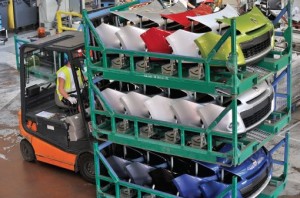 Faurecia currently uses four pan-European crossdocks, with plans to roll out two more this year. It shares some of these facilities with the exteriors division
Faurecia currently uses four pan-European crossdocks, with plans to roll out two more this year. It shares some of these facilities with the exteriors division “This habit is still common, but we have to resist it, because to build a really effective FCA network, we have to plan it right from the beginning,” he says.
For the interior group, 90% of freight moves by road, with 10% moving in ocean containers. For the road freight, around 90% is in consolidated flows, with 10% full truckloads from suppliers.
Of the consolidated truck flows in Europe, about 10% now move through the crossdock network, with the rest classic milkruns. The interior division currently has four crossdocks (which it shares sometimes with the exterior group): one near Lisbon, Portugal; two in France, with one close to the Spanish border in San Sebastian and the other at the 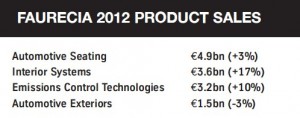 German border in Mulhouse; and one in Pitesti, Romania. By the end of the year Faurecia will add another in Germany, and one in either Poland or the Czech Republic.
German border in Mulhouse; and one in Pitesti, Romania. By the end of the year Faurecia will add another in Germany, and one in either Poland or the Czech Republic.
“The distance between each crossdock corresponds to the legal distance that a driver can drive at one time,” said Louwerse. “If the distance is longer – such as between San Sebastian and Mulhouse – we have a switch point for drivers to ensure the trailer doesn’t stop.”
Louwerse speculates that in future Faurecia could also use the crossdocks for domestic part pickups in each country, but this would require an entire reorganisation of the transport network. “We prefer to move step by step right now,” he said.
Thanks to improvements in consolidation and pack density, Faurecia has improved its truck utilisation to 70% from around 50% a few years ago.
Increasing the use of returnable packaging
One way that Louwerse believes truck utilisation can be improved is by increasing the amount of standardised, returnable packaging by Faurecia’s tier two suppliers.
“Returnable packaging is more efficient in terms of pack density and for environmental sustainability,” Louwerse says.
He points to a significant standardisation project for ocean container shipping, much of which had been surprisingly non-standard just five years ago. “We have an ocean crossdock at the port of Antwerp, where I saw crazy things in terms of the packaging suppliers were using to send us components,” he says. “In one case, rather than applying a caution sign, a supplier glued a safety cone atop a pallet, which made it impossible to stack.”
While negotiations are still ongoing, Louwerse can point to container filling rates that have increased from 45% to 80%. “It’s a big improvement but it took five years!” he says.
"The core project in the future will be to implement a global supply chain management that would harmonise the production needs and better manage the daily operational needs of the supply chain" – Marc Louwerse, Faurecia Interior Systems
The interiors division currently uses about 70% ‘one-way’ or disposable packaging, and 30% returnable. The disposable packaging is typically cardboard, bag covers and wood for kits and pallets. “If we’re buying so much one-way packaging, it is because part of our packaging is for the aftermarket, and all the parts sent overseas in CKD [complete knockdown] kits are always one way.”
Returnable packaging is made of plastic boxes, metal racks and containers. “We use metal containers for interior panels, door panels and central consoles for final delivery to OEMs. Parts sent separately usually move in plastic boxes.”
Faurecia uses standard dimensions for the external shape of metal racking, which allow double stacking in trucks; the internal shapes of the packaging vary according to the products.
Faurecia purchases most returnables plastic boxes from two large European suppliers. It sources some packaging from local suppliers, but it prefers larger suppliers with local production capacity in the US, Russia and China.
“For Russia it is particularly important to get packaging locally because if you buy a standard Gallia or KLT [pallet] from France or Germany and ship it to Russia, you pay customs and duty that double the price,” says Louwerse.
Global supply chain challenges
Faurecia continues to develop its global supply chain. Louwerse says the interiors division has recently achieved similar levels of efficiency in North America as it has in Europe, while plants in Thailand are remarkably good for logistics. Elsewhere, improving logistics can be difficult – in China, for example, Faurecia’s joint venture structures mean that Louwerse has little visibility on the domestic network.
 One market where Louwerse has been spending a considerable amount of time has been Russia, where Faurecia has interior plants in both Kaluga and the St Petersburg region. While production is growing strongly, the market has many well-documented complexities, including an underdeveloped local transport sector. “There are a number of global third party logistics providers which are developing in Russia, but the local transport market is somewhat prehistoric,” he said. “It’s difficult to find reliable Russian providers, which is challenging when you’re moving from our plant in Luga [near St Petersburg] to Ford in Yelabuga [a distance of 1,600km].”
One market where Louwerse has been spending a considerable amount of time has been Russia, where Faurecia has interior plants in both Kaluga and the St Petersburg region. While production is growing strongly, the market has many well-documented complexities, including an underdeveloped local transport sector. “There are a number of global third party logistics providers which are developing in Russia, but the local transport market is somewhat prehistoric,” he said. “It’s difficult to find reliable Russian providers, which is challenging when you’re moving from our plant in Luga [near St Petersburg] to Ford in Yelabuga [a distance of 1,600km].”
Faurecia imports most of the material for Russian production from Europe. “It’s a big challenge. We want to localise, but we’re finding quality issues in the Russian supply chain. For example, we cannot find a good local manufacturer for plastic parts, so we import them from France, Germany and Spain,” he says.
European material for interiors moves to Russia by road. While customers such as PSA and Volkswagen move to Russia by rail, Louwerse says that the carmakers aren’t interested in combining flows with suppliers’ inbound material. Louwerse is now studying short-sea container shipping as a possibility, especially as an alternative to road during winter.
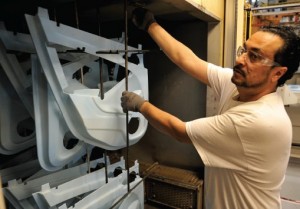 Faurecia has been expanding its presence in Russia, although most of the supply chain for these plants is still based in Europe
Faurecia has been expanding its presence in Russia, although most of the supply chain for these plants is still based in EuropeAlong with its continued global expansion, Louwerse believes that a global supply chain management organisation will at some point be an important part of Faurecia’s logistics management in the future, whether at a group or divisional level. He believes it would involve integration across purchasing and operations, and include a more integrated IT and communication system for sharing forecasts, planning and real-time activity across the supply chain.
“I think that the core project in the future will be to implement a global supply chain management that would harmonise the production needs and better manage the daily operational needs of the supply chain,” he said.





